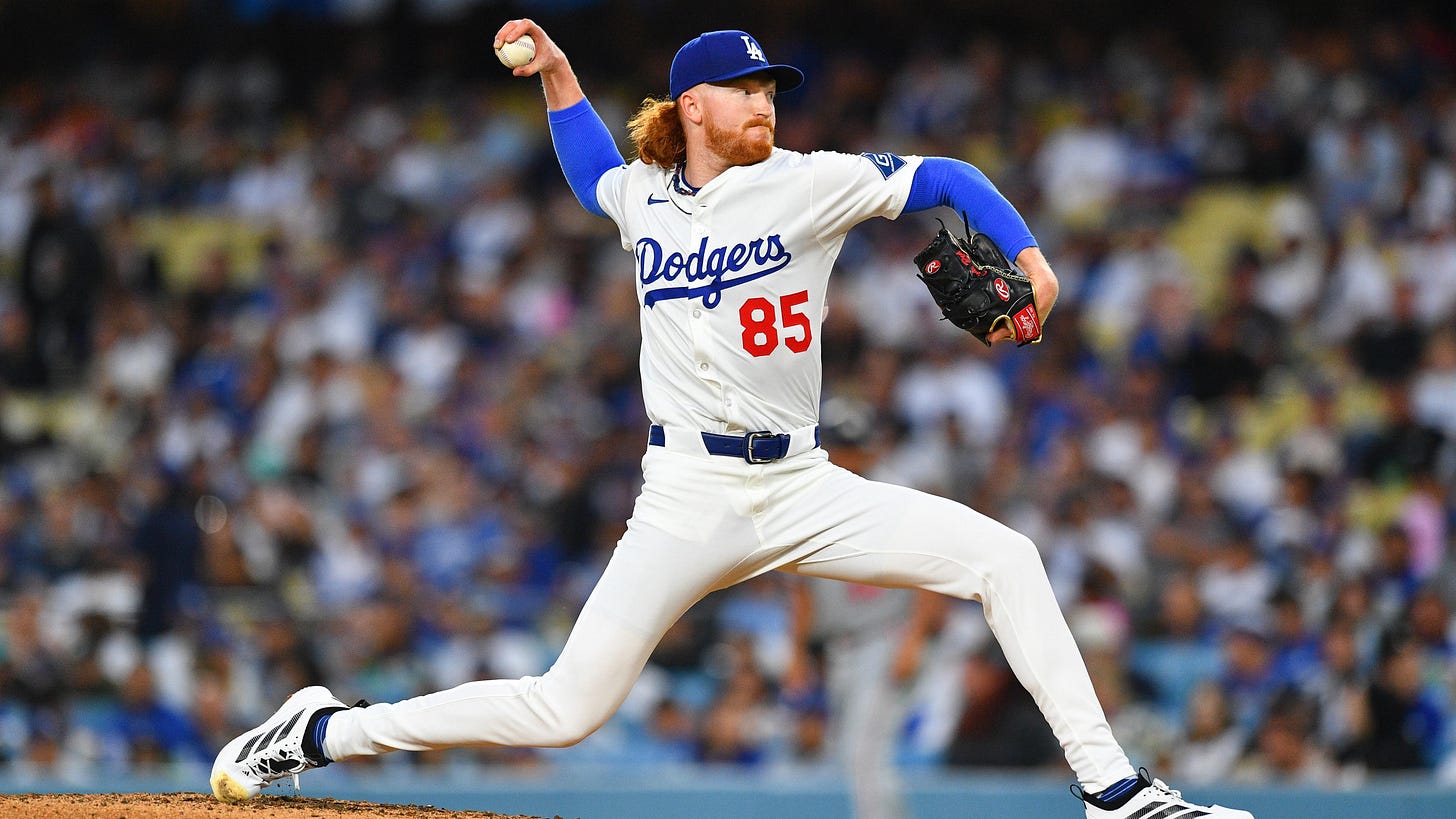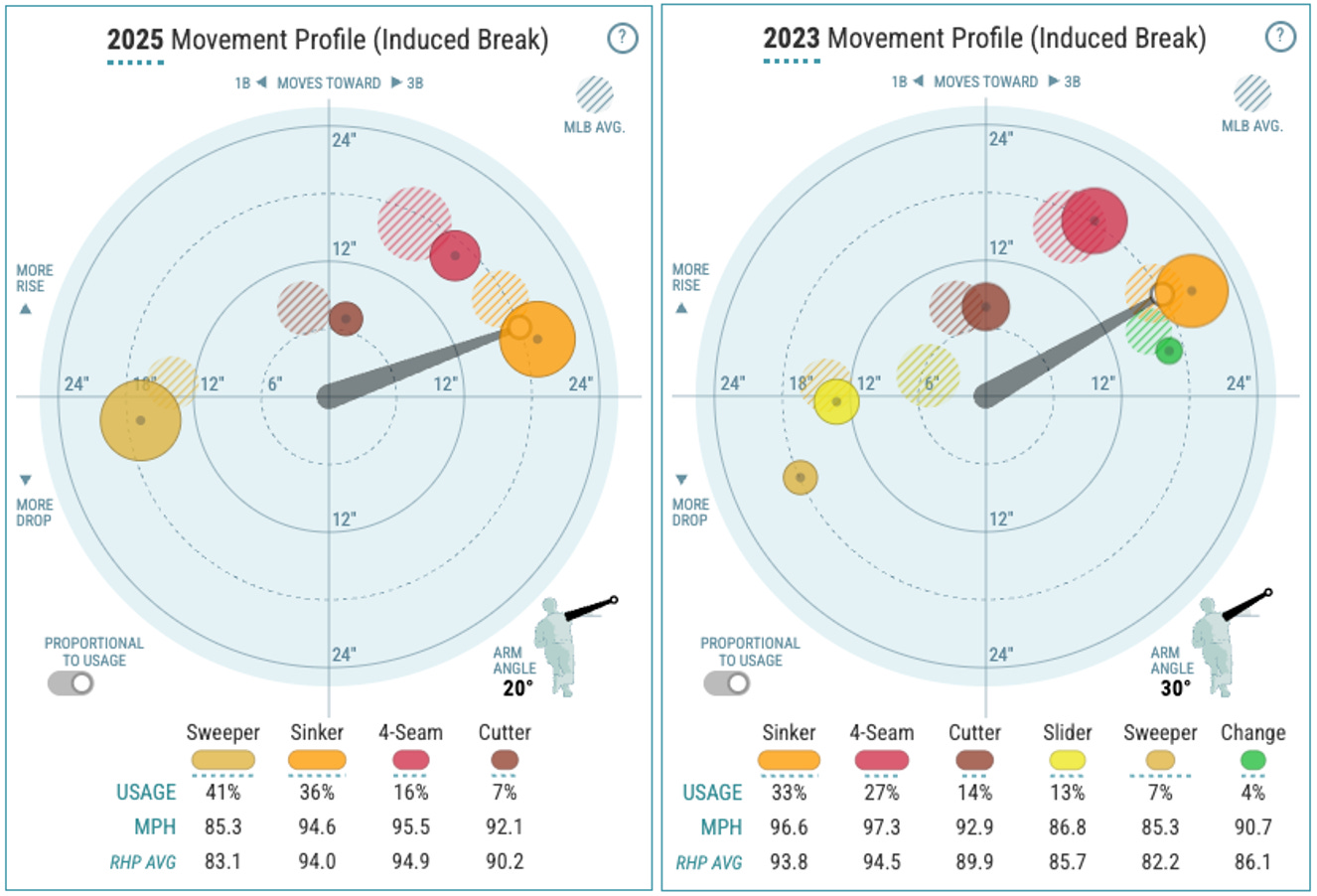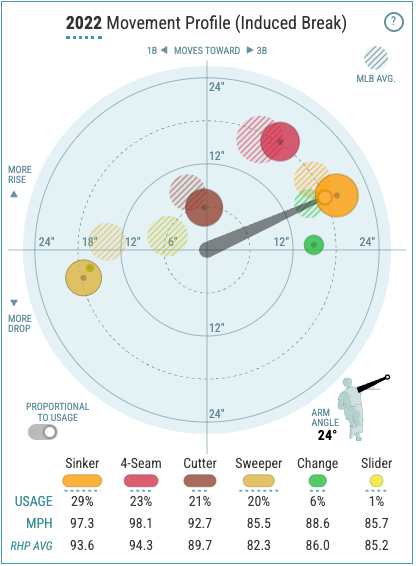How Can the Red Sox Get Dustin May Back on Track? One Potential Solution, With a Catch
It’s been almost a week since the trade deadline, and today Red Sox fans will get their first look at new addition Dustin May. May is a 27-year-old starting pitcher acquired late deadline day in exchange for prospects James Tibbs III and Nate Ehrhard. A 2016 3rd round pick, May peaked as Baseball America’s #2 Dodgers prospect and #20 prospect in the sport in 2020. He’s been a star on Pitching Ninja for years for throwing mind-bending pitches like these:
https://x.com/PitchingNinja/status/1917040141094289644
https://x.com/PitchingNinja/status/1904715404204728679
The difficult thing about analyzing May is that, although he’s been on the MLB radar for quite some time as a high-ceiling starter, the sample sizes are quite small. May has seen MLB action in six out of the last seven seasons, but had never pitched more than 70 major league innings in a single year until this one, thanks to various injuries. After debuting for 34.2 IP as a 21-year-old in 2019, May pitched 56 innings (plus 10.2 postseason innings during the Dodgers’ World Series run) in the shortened 2020 season. He had Tommy John surgery after just 23 IP in 2021, returning briefly in late-2022 and early-2023 before flexor tendon surgery caused him another long absence. Just as he was to begin rehabbing from that 2023 surgery, May had a life-threatening esophageal tear he suffered in a freak accident while eating a salad. The incident forced him to miss another 6 months and the entire 2024 season. This year’s 104 IP are by far a career high for May, which is a positive, but his 4.85 ERA represents a career worst and a far cry from the 3.10 career ERA he carried entering the season.
When searching for things that could be amiss for May, two things immediately stick out. First, his sinker, which he throws well over 30% of the time, is getting uncharacteristically crushed this season. Opponents are hitting .285 and slugging .589 off the pitch, and the expected numbers are even worse at .347 and .633, according to Baseball Savant. In 2023, his most recent MLB season before this one, opponents managed just a .161 batting average and .232 slugging percentage off May’s sinker. A portion of the drop off in effectiveness for this pitch is likely related to a drop in velocity. May averaged 96.6 mph on the pitch in 2023 and is averaging 94.6 mph on it this season. The drop is understandable given May’s injury history, but I don’t think it tells the whole story here.
Which leads me to the second thing that immediately stuck out: a difference in arm angle. Though May’s arm angle has fluctuated a bit over the years, it’s at comfortably the lowest it’s ever been this season. At just 20 degrees, this new angle represents a 10-degree drop off from when we last saw May in 2023. Take a look at the two Baseball Savant charts below demonstrating what’s happening to his pitches as a result of this shift:
The solid-colored circles on these charts represent the average movement profiles of each pitch in May’s repertoire. The more transparent, shaded circles nearby represent the average expected movement of that pitch type, or the movement the hitter might be used to seeing from the average right-handed pitcher’s version of that pitch. What you’ll notice is that with this season’s lower arm angle, May’s sinker (in orange) and four-seam fastball (in red) each drop a lot more than they used to. The 2023 versions had much closer to average “rise” — a desirable trait in a fastball — while maintaining that greater-than-average arm-side movement. These traits helped make those pitches more effective in and at the top of the strike zone, where he tends to throw them most often.
So, is the simple solution here for May to raise his arm angle back to 30 degrees? I mentioned in the title that this potential solution came with a catch. The catch is this: May lowered his arm angle intentionally, since the lower slot was more comfortable for him to throw out of post-injury. If this newer arm angle is part of what’s keeping May healthy this season, it might not be something he’s willing to change back. Perhaps there’s some middle ground that can be found, though, in his pitch data from 2022:
In 2022, May’s arm angle was at 24 degrees, almost square in the middle of his 2023 and 2025 campaigns. Although the 2022 season was the second-worst ERA of May’s career at 4.50, his expected ERA that season was much lower at just 3.67 and much better than his current 4.90 xERA in 2025. It’s possible that a small adjustment halfway to his 2023 arm slot could give him back just enough of the rise his fastballs need to be more effective in and at the top of the strike zone, while still resting in a comfortable zone for the health of his elbow and shoulder.
It’s also possible, though, that May’s best will never be unlocked without that 30+ degree slot. His best work has always come from that angle or above, and at the lower angles, he’s much more of an East-West pitcher in the vein of Tanner Houck. In fact, it’s worth noting that Houck is graded as the single most similar pitcher to the 2025 version of May in terms of velocity and movement, according to Baseball Savant. Though that comparison might spook some people given what we saw from Houck this year, we have seen a healthy Houck be very effective for stretches. Here’s hoping that if there is indeed no adjustment to be made with May’s arm angle, we at least get the red-headed version of Houck’s very best.







